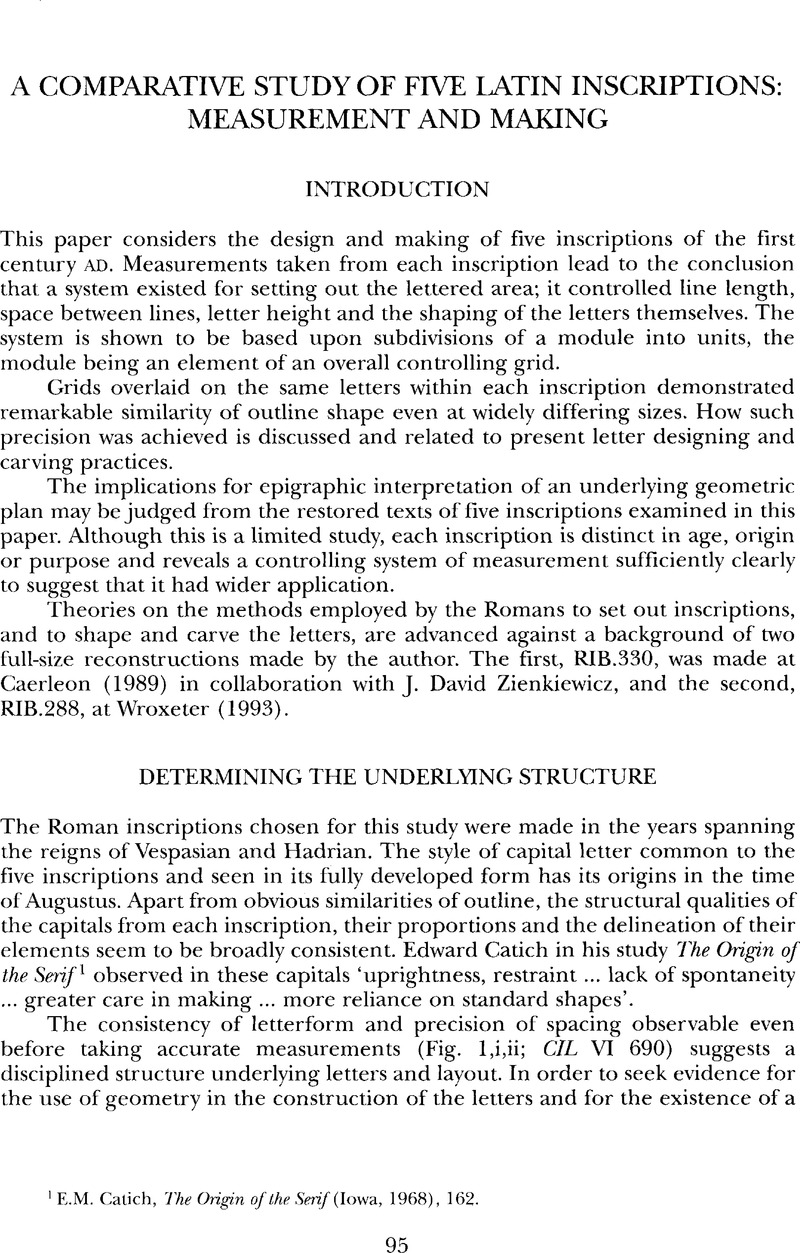Article contents
A Comparative study of five latin inscriptions: measurement and making
Published online by Cambridge University Press: 09 August 2013
Abstract

- Type
- Articles
- Information
- Copyright
- Copyright © British School at Rome 1996
References
1 Catich, E.M., The Origin of the Serif (Iowa, 1968), 162.Google Scholar
2 Mallon, J., Paléographie romaine (Madrid, 1952)Google Scholar, ch. 2, paragraphs 99–111.
3 Zienkiewicz, J.D., The Legionary Fortress Bath at Caerleon: I. The Buildings, II. The Finds (Cardiff, 1986).Google Scholar Zienkiewicz explained the metrology of the fortress buildings in terms of a pes castrensis. This was applied to the inscription RIB.330 and he has provided his interpretation of the measurements for this study.
4 Jones, M. Wilson, ‘One hundred feet of spiral stair; the problem of designing Trajan's Column’, Journal of Roman Archaeology 37 (1993)Google Scholar, conclusion 5. The length of the foot implied is 0.2967 m, not quite within the ‘normal’ 0.294–0.2965 m range, but close enough not to be called into question.
5 Gordon, A.E. and Gordon, J.S., Album of Dated Latin Inscriptions (Los Angeles, 1965)Google Scholar, a. no. 139. Squeeze of CIL XIV 86.Google Scholar This squeeze does not clearly distinguish between plaster infill around the stone and the stone itself. The tops of the letters of line 1 do not accurately represent letter shape and height.
6 Keppie, L., Understanding Roman Inscriptions (London, 1991)Google Scholar, plate 35, milestone.
7 RIB.288. The commemorative slab is carved in sandstone and was found in 1924. It is fully restored and displayed at Rowley's House Museum, Shrewsbury. Cf. Webster, G. and Barker, P., Viroconium. Wroxeter Roman City (London, 1978), 8Google Scholar, right-hand column, lines 1–17. The letters were not carved by a ‘master carver’. The evidence suggests only that the carving of the letters was adequately executed within an accurate framework of scribed lines. The work should not be compared to the Trajan's Column inscription, CIL VI 690Google Scholar; the two are proportioned, made and carved entirely differently and the letters express those differences. While the layout and scribing of the outlines may suggest the work of a craftsman ‘probaby sent for the purpose from Rome’, the carving does not.
8 Haselberger, L., The Construction Plans of the Temple at Didyma (New York, 1985), 116Google Scholar (mineral pigment used to make drawing stand out), 119 (design process), 120 (inscribed lines on stone).
9 Catich, , The Origin of the Serif (above, n. 1), 220–2.Google Scholar
10 Mallon, J., Une inscription latine incomplètement gravée (Archéologie-Epigraphie 3) (Libyca, 1955), 155–62.Google Scholar Letters in the lower four lines of the inscription are in outline only while the remainder are V-cut.
11 Felice Feliciano of Verona (1432–80) is credited with the first constructed alphabet, though it is by no means certain that the inspiration for it was his. Da Moyles's printed version may have introduced the idea to more scholars but the later works of Pacioli and Dürer bear only a passing resemblance to it. Dürer, A., Of the Just Shaping of Letters (New York, 1965Google Scholar (reprint)), is an accessible manual for the study of one approach to the construction of Roman letters in this period.
12 Brunés, T., The Secrets of Ancient Geometry (Copenhagen, 1967)Google Scholar, ch. 18, ABC of the Modern Alphabet. The origins are proposed for Phoenician letters and their adaptations to Greek and Roman alphabets.
13 Evetts, L.C., Roman Lettering (London, 1938)Google Scholar, contains plates of each letter with corresponding geometry.
14 Catich, E.M., Letters Redrawn from the Trajan Inscription in Rome (1968).Google Scholar Catich made line drawings of the outlines of each letter from observations of the stone, tracings and chalk rubbings. Where outlines on the stone were unclear he omitted those parts. Photographs which he made in the 1950s are useful in studying subsequent erosion.
15 In The Scottish Society for Conservation and Restoration 6 (February 1995), 7–9.Google Scholar
- 3
- Cited by




